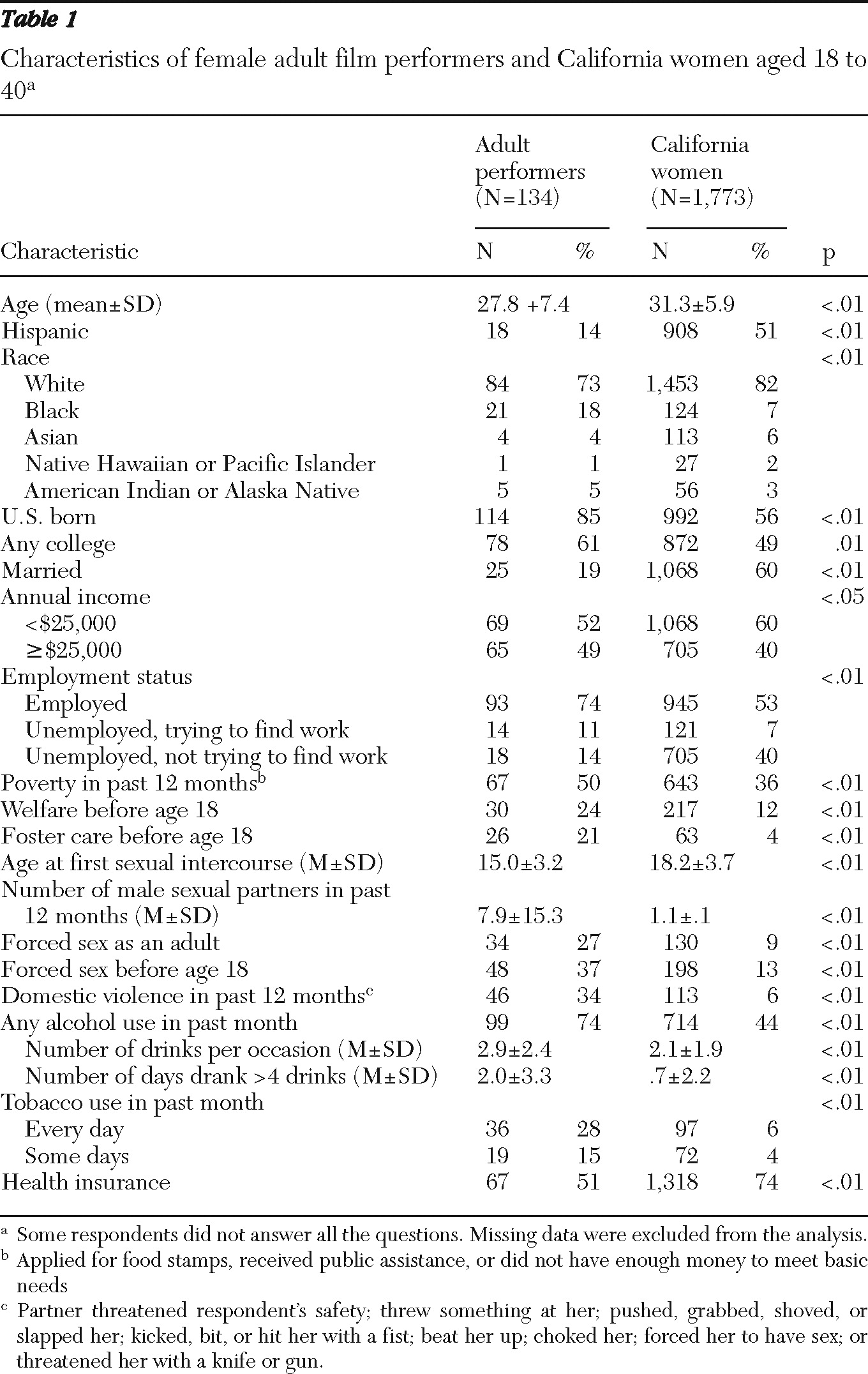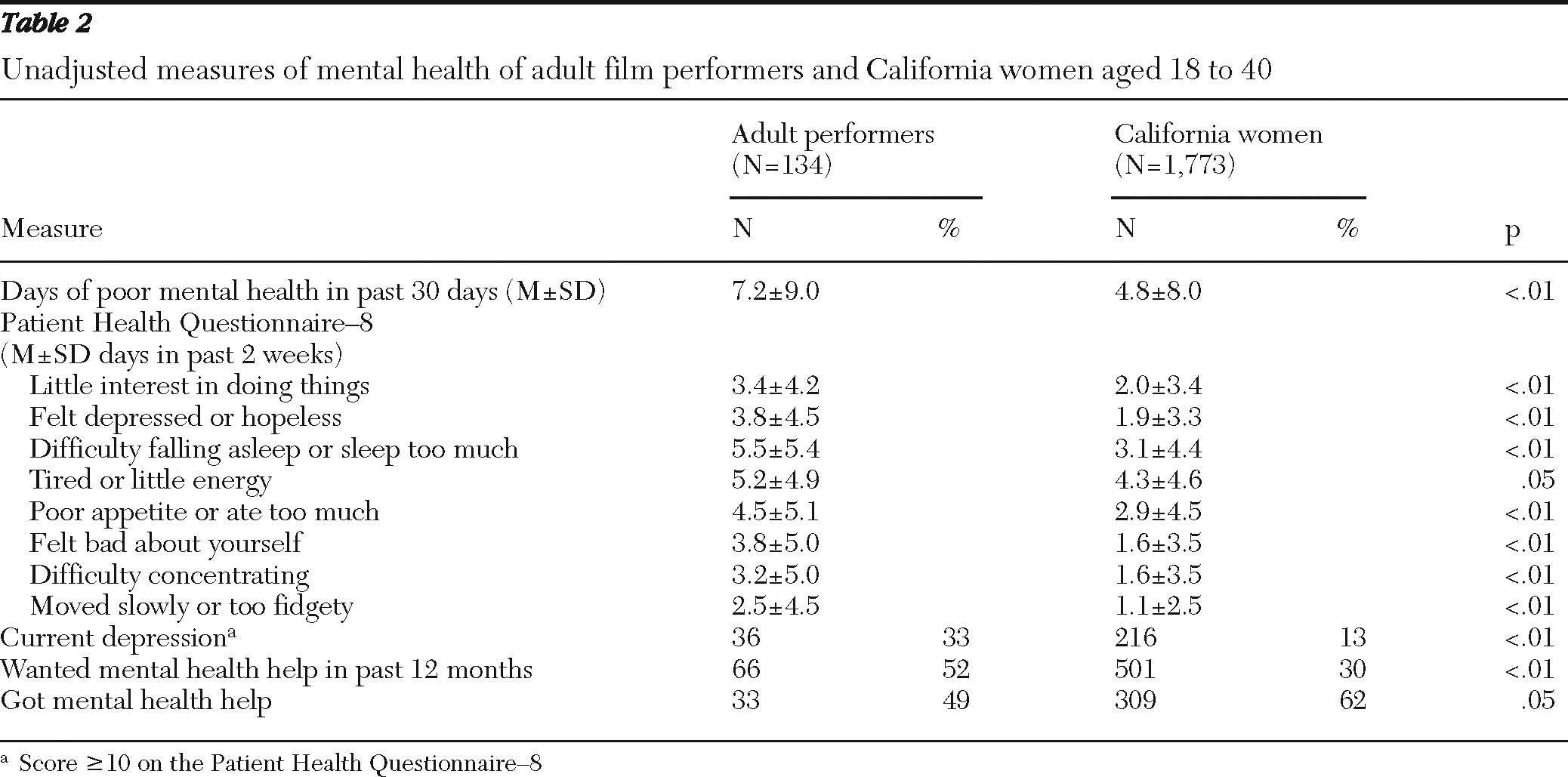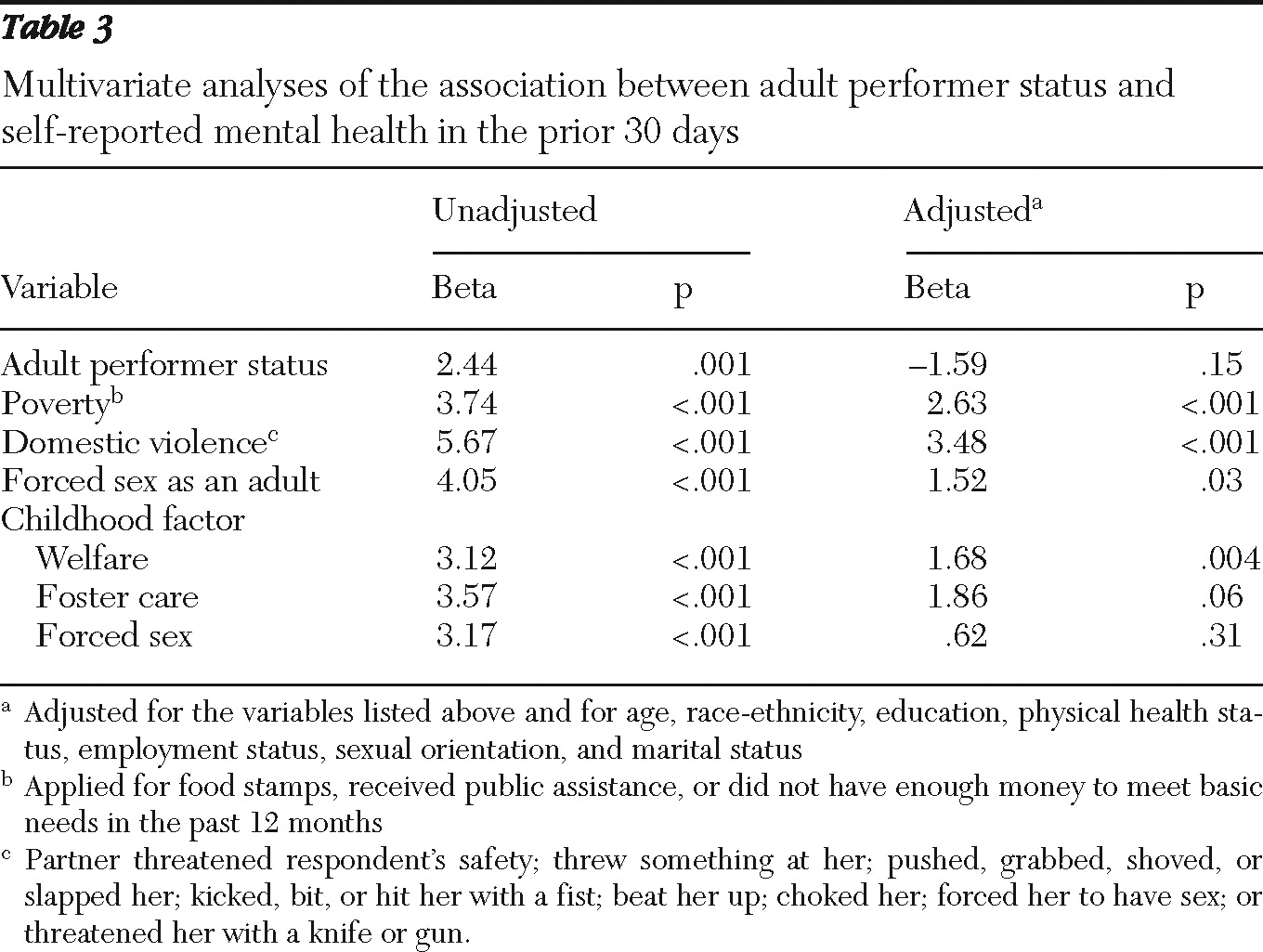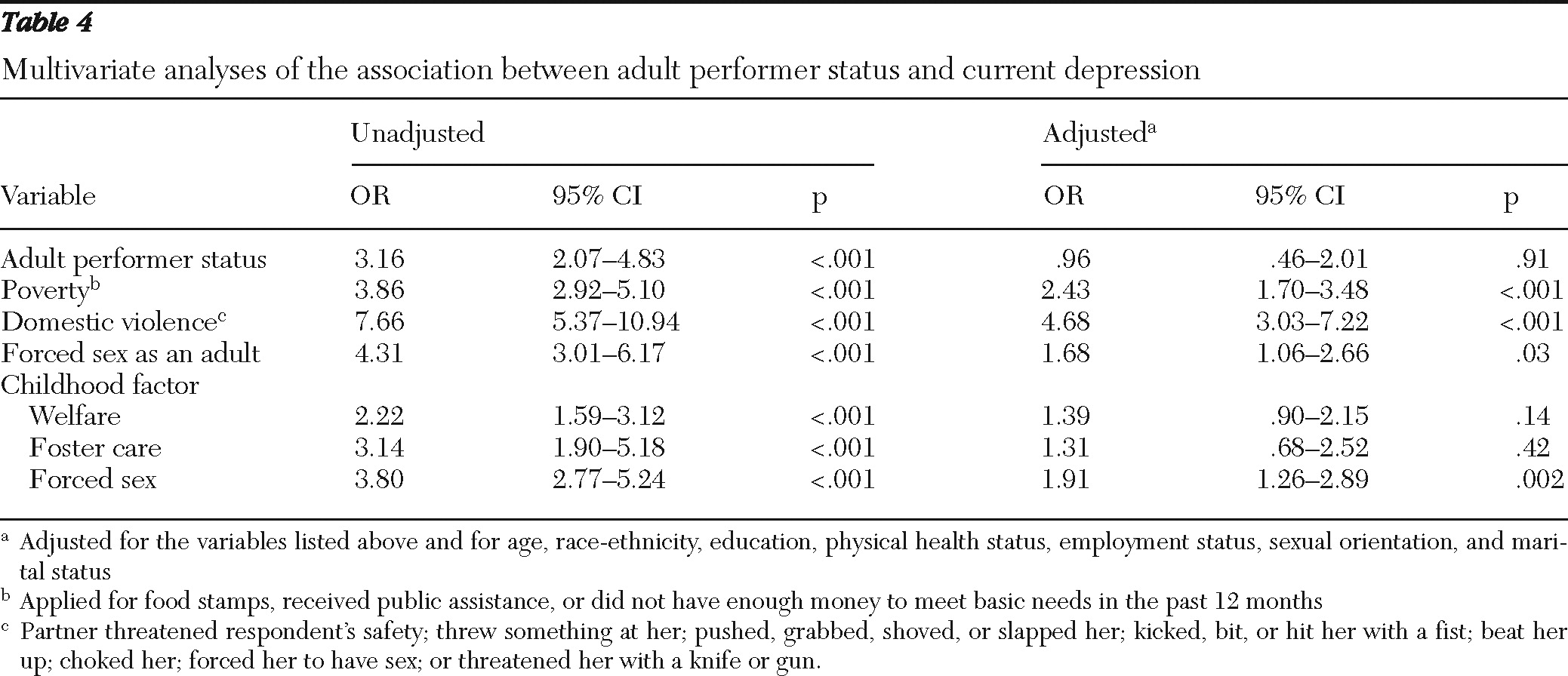Concerned about the potential health threats that pornography might present to individuals and the public, former Surgeon General C. Everett Koop convened the first-ever “Workshop on Pornography and Public Health” in 1987 (
1). Despite the expert panel's conclusions that pornography “impairs the mental, emotional, and physical health” of individual participants, viewers, and society at large, the United States remains the largest producer of pornography in the world. More than 200 companies produce thousands of heterosexual pornography video titles a year, employ hundreds of performers, and report over $1 billion in sales (
2). With the advent of the Internet and digital video, adult video content has become widely accessible at little or no cost to the viewer. Pornography is protected under the First Amendment unless it is deemed “obscene” by local community standards, which vary by jurisdiction (
3). Child pornography, defined as content that includes participants less than 18 years old, is not considered free speech and is censored under the Child Protection and Obscenity Enforcement Act (
4).
Although the effects of pornography on viewers are still debated, the threats to the health of participants are not. Adult film performers regularly engage in sexual acts without barrier protection against sexually transmitted infections, including HIV (
5). Some performers are routinely tested for HIV, gonorrhea, and chlamydia (
6,
7); however, screening does not prevent transmission of disease, because exposure can occur between tests, and HIV in particular has a window period during which results can be negative (
8). Transmission of HIV (
9–
12) and a high incidence of gonorrhea, chlamydia, and genital warts (
6) have been reported among male and female performers. Adult film producers, like all employers of any legal commercial enterprise, are required to comply with California Occupational Safety and Health Administration law that requires protection of employees against any potentially infectious bodily fluid (
13). Despite clear regulations specific to the adult film industry (
14), condom use remains rare (
5,
6).
Research on the mental health effects of pornography has focused on viewers and the public at large, rather than on participants in adult films. Although the occupational health risks of the adult film industry are well known, there is reason to believe that performers' mental health also deserves study. Mental health problems (
15–
25) and other associated health risks, such as perpetration of sexual and physical violence (
26–
32), have been documented among commercial sex workers. However, it is unclear whether similar problems exist for adult film performers or whether performers are different from age-matched individuals in the general population. Qualitative interviews with adult performers suggest that female performers in particular, like other commercial sex workers, are often victims of sexual and physical violence and have a variety of mental health problems, including alcohol and drug abuse and addiction and depression (
7). These problems have not been quantified in this population, and it is unclear whether rates are different from those among other young women.
The objectives of this study were to describe current mental health status and associated health risks and behaviors of female adult film performers, to compare their self-reported mental health status with that of young California women, and to compare the rate of current depression in both groups. These data will help guide interventions to improve the health status of female adult film performers and will also inform advocacy groups and policy makers.
Methods
Overview
We created a cross-sectional structured online questionnaire based on the 2007 California Women's Health Survey (CWHS). The questionnaire was self-administered to a convenience sample of current female adult film performers via the Internet. Participants were recruited from August 28, 2008, through June 16, 2009. Analyses were conducted to compare the self-rated mental heath status and rate of current depression of performers and CWHS respondents aged 18 to 40. Informed consent was obtained from all participants, and all study procedures were approved by the University of California, Los Angeles, Institutional Review Board.
Sample, sampling procedure, and setting
Female adult film performers were eligible if they had performed in at least one adult film released in the past six months and they could be contacted via the Internet. Approximately 2,300 new heterosexual adult films were released in the six months before the study. Contact information was obtained from either the Internet Adult Film Database (
www.iafd.com), the most comprehensive database of heterosexual adult films within the United States, containing 99,999 unique titles, or an adult film jobs Web site (
www.sexxyjobs.com), which hosts Web pages for hundreds of adult film performers seeking work. From September 2008 to January 2009, performers were identified through cast lists of videos released during the two weeks before the search. Compilations (collections of previously released scenes) were excluded from our online search to minimize the time from production to inclusion in the database.
Performers were sent an e-mail or electronic message with a link to complete the online survey. Unless a performer asked to be removed from our e-mail list, the e-mail was sent up to 12 times to nonrespondents until we reached our target sample size of 130 participants. Performers were offered a $50 online gift card as an incentive for participation.
E-mail contact information was available for 192 of the 476 female performers (40%) listed in the adult film database and for all 848 female performers on the jobs Web site. We sent e-mails to these 1,040 individuals and received 166 responses (response rate of 16%). Compared with the 225 nonrespondents for whom demographic data were available online, the respondents did not differ significantly in age, time spent working in the adult film industry, percentage born in the United States, or race-ethnicity. Thirty-two of the respondents were excluded from the analysis because they completed the survey in less than four minutes (three seconds per question), and most of their responses lacked any variability.
Instrument
Our survey instrument was adapted from the CWHS, an annual telephone survey that collects information from a sample of approximately 4,000 randomly selected adult women aged 18 years or older on a wide variety of health indicators and health-related knowledge, behaviors, and attitudes. The CWHS is designed collaboratively by the California Departments of Health Services, Mental Health, Alcohol and Drug Programs, and Social Services and is administered by the Public Health Institute.
We used CWHS variables from the following domains: demographic characteristics, health access, mental and physical health status, sexual health, sexual and physical trauma, and health behaviors. To further describe the adult film sample, we added questions important to this population, including history of working in adult films, work practices, illicit drug use, and HIV testing. These additional questions were drawn from our own pilot work with this population (
7) and from the Los Angeles County Health Survey. To preserve the general order of survey topics in the CWHS, these new items were added to already existing CWHS domains (for example, questions regarding illicit drug use were inserted after alcohol use in the health behaviors domain). The final 78-item instrument was pilot tested in various formats online (for example, with use of one question or multiple questions per page and use of various font sizes) to assess ease of use and time to complete.
Data collection
Potential participants were sent an invitation e-mail with an online link to a Web-based consent form. After they verified that they were 18 years or older and had performed in an adult film in the prior six months, participants indicated consent and were then taken to a unique link with a brief description of the survey topics and expected time to complete (15 minutes). The site also informed them of the anonymity of their responses. Participants were required to choose a response or indicate refusal to answer before proceeding to the next question. To allow for flexibility but prevent duplication, respondents could return to the survey multiple times, but they could no longer access the unique link once the survey had been completed. Responses were transmitted in real time to a separate URL, where the research team could download the responses according to a randomly chosen unique identification number. No link could be made between a participant's e-mail address and her responses to the survey. Participants who completed the survey were sent an e-mail containing an online gift card.
Primary data analyses and outcomes measures
Our two primary outcomes were self-reported mental health status and current depression. The former was measured with the quality-of-life questions from the Behavioral Risk Factor Surveillance Survey (BRFSS) core instrument, which correlate strongly with scores on the Short Form Health Survey and other self-reported measures of health (
33–
35). Current depression was assessed with the BRFSS depression screen, also known as the Patient Health Questionnaire-8 (PHQ-8). The BRFSS core quality-of-life question for mental health reads, “Now thinking about your mental health, which includes stress, depression, and problems with emotions, for how many days during the past 30 days was your mental health not good?” The PHQ-8 has been shown to be a valid diagnostic and severity measure for depressive disorders (
36). A score of ≥10 was used as the cutoff point because it has been shown to represent current clinically significant depression (
37). Our main independent predictor was work in the adult film industry.
To ensure better comparability on age, we compared the 134 survey respondents who met our inclusion criteria (mean age=27.8 years, median=26, range=17–54) to CWHS respondents aged 18 to 40 (N=1,773; mean age=31.3 years, median=32). Descriptive statistics (frequencies, means, and standard deviations) were calculated on all outcome and predictor variables for the two samples. We then compared the two samples using standard statistical analyses (chi square and two-sample t tests) on demographic characteristics and prior and current health risks and behaviors. Associations between hypothesized predictors and self-reported mental health status and depression were examined with correlation for continuous predictors and analysis of variance for categorical predictors in the combined sample.
Multiple linear regression models were fit to the data to control for possible confounders in estimating the effect of adult performer status on mental health status and depression in the combined sample. Model specification was guided by empirical findings from the bivariate analyses (p<.10) and by prior hypotheses. Multicollinearity was assessed for final regression models, and standard diagnostics were used to ensure the integrity of the models. All analyses were performed using SAS version 9.1.
Results
Characteristics of participants
The 134 performers had spent a mean±SD of 3.6±4.3 years working in the adult film industry. A total of 122 women (91%) had performed penile-vaginal intercourse on the set with male performers, and 121 (90%) used condoms inconsistently or not at all.
Table 1 summarizes data for the performers and the 1,773 respondents to the 2007 CWHS aged 18 to 40. On average, compared with CWHS respondents, the performers were more educated and more likely to be employed but were less likely to be married, to be born outside the United States, and to have health insurance (p<.01). The performers were also more likely than the CWHS respondents to be black and less likely to be Hispanic, white, or Asian. Over the previous year, 50% of performers could not meet their basic living needs, compared with 36% of CWHS respondents (p<.01).
Table 1 also presents data on traumatic events. During childhood, the performers were more likely than CWHS respondents to have experienced forced sex (37% and 13%), to have lived in a household that received public assistance (24% and 12%), and to have been removed from home by the government or court (21% and 4%) (p<.01). The performers experienced first sexual intercourse an average of three years earlier than CWHS respondents, and they reported an average of 7.9 personal sexual partners in the prior 12 months, compared with 1.1 for CWHS respondents (p<.01). The performers were also more likely than CWHS respondents to have experienced physical and sexual trauma as adults. Twenty-seven percent reported having had forced sex as adults, compared with 9% of the CWHS respondents, and 34% reported that their safety had been threatened by a partner or former partner in the past 12 months, compared with 6% of CWHS respondents (p<.01). Performers were more likely to smoke cigarettes daily (28% and 6%) and to use alcohol (74% and 44%) (p<.01).
Mental health status
Bivariate analyses are shown in
Table 2. Mental health was significantly worse among the performers, who experienced more days of poor mental health in the past month than CWHS respondents (7.2 compared with 4.8 days; p<.01). The performers had lower summary and individual scores on all eight questions of the PHQ-8 (p<.01 for all differences except number of days of feeling tired and with little energy in the past two weeks, p=.05). Thirty-three percent met criteria for current depression based on the PHQ-8 score, compared with 13% of the California women of similar age (p<.01).
Multivariate analyses were conducted with the quality-of-life measure for self-reported mental health status from the BRFSS core instrument as the dependent variable and adult film performer status as the independent predictor (
Table 3). After the analysis controlled for demographic characteristics and health risks and behaviors, factors that remained significantly associated with mental health in the past 30 days included general medical health, poverty, domestic violence, forced sex as an adult, and childhood in a household receiving welfare (p<.05). Adult film performer status, foster care as a child, and forced sex before age 18 were no longer significant predictors of mental health status in the multivariate model.
A second multivariate analysis was conducted with a positive BRFSS depression screen (PHQ-8 score ≥10) as the outcome variable (
Table 4). Many of the same variables remained significant predictors of mental health status, in addition to forced sex as a child or adolescent (p<.05). Adult film performer status was no longer predictive of current depression after the analysis controlled for the same covariates as in the previous model.
Discussion
Our study found that female adult film performers were more likely than other young women in California to be depressed and to have significantly worse mental health. The performers reported poor mental health on more than seven days in the past 30 days, and a third met criteria for depression. Although we cannot determine causation, the association between adult performer status and poor mental health was consistent and highly significant. The bivariate differences in mental health status and depression between adult film performers and other young women were no longer significant after the analyses controlled for domestic violence and childhood sexual assault. This finding may partly explain why the performers, who had a significantly higher prevalence of physical and sexual trauma, had worse mental health and a higher rate of depression.
Potentially traumatic experiences during childhood were not uncommon among the young women we studied, although the prevalence among the adult film performers was exceptionally high. Over a third of the performers were forced to have sex as children or adolescents, and over a fifth had been removed from their home as children by a government or court. Previous studies have shown that potentially traumatic experiences in childhood, such as those experienced by female adult film performers, are associated with higher rates of depression and poor mental health outcomes later in life (
38–
43).
The relationship between occupation and mental health is complex, and observational studies cannot elucidate cause and effect or account for all the potential confounders. It will always be difficult to determine whether certain industries self-select for persons with mental health problems or whether they exacerbate these problems, or both. Nonetheless, it is clear that many female performers in the adult film industry have profound mental health problems and have been victims of physical or sexual trauma.
Mental health status varies by occupation (
44–
46), although it is unclear how much of the variation is due to socioeconomic status, education, or other factors. Most of the historical focus on occupational health has been on the physical hazards in the workplace. However, there is an increasing emphasis on measuring the impact of the psychosocial work environment on mental health. Even less clear is the role that industry should play in helping to prevent or treat mental health problems among employees. Nonetheless, the high prevalence of depression and other mental health problems among female adult film performers should raise alarms, especially for a legal, billion-dollar industry that falls under California's Occupational Safety and Health Administration jurisdiction.
Despite the significance of our findings, the most important limitation of our study is the lack of longitudinal data, which would help us better understand whether and how working in the adult film industry influences health-related behaviors and mental health status. Other limitations prevent us from drawing definitive conclusions about the mental health of adult film performers. First, our sample was not representative of all adult film performers; potentially more vulnerable populations, such as non-English speakers and those without Internet access or electronic contact information, were excluded. Our data were also limited by a low response rate, which may have resulted from rapid turnover in the industry. Finally, our survey was self-administered via the Internet, whereas the CWHS was administered person-to-person over the telephone. Surveys containing sensitive topics, such as questions regarding sexual practices, yield more accurate responses when they are self-administered (
47).
Conclusions
Despite its limitations, our study found an alarming rate of mental health problems and associated trauma among female adult performers. Not only were they exposed to physical health threats in the workplace, but they also reported serious mental health problems and high rates of physical and sexual violence. Treatment is needed to address these problems. Beyond ensuring access to mental health services, it is up to policy makers and the general public to decide how to approach this occupational health crisis. Options include mandatory mental health screening before entering the industry, mandated treatment paid for by the industry, and financial penalties for production companies that do not follow these practices. Future studies could compare the mental health status of employees in this industry and other industries. However, it is hard to imagine that policy makers or the public would tolerate similar rates of mental illness in any other legal, billion-dollar industry.
Acknowledgments and disclosures
This project was supported by an Innovative, Developmental, Exploratory Award (IDEA) from the California HIV/AIDS Research Program, University of California Office of the President. The funding entity had no role in the design and conduct of the study; collection, management, analysis, and interpretation of data; and preparation, review, or approval of the manuscript. Dr. Morrison was supported by a Mid-Career Investigator Award in Patient Oriented Research (K24 AG022345) from the National Institute on Aging. The authors thank the California Women's Health Survey Workgroup for providing access to the 2007 CWHS data set.
The authors report no competing interests.





